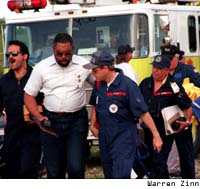![[HLINK]](../gen_art/bug_mo.gif)
Published Sunday,
Wreckage may be sunk in marsh
By TONY PUGH and CYRIL ZANESKIHerald Staff Writer
 RETURNING FROM THE SCENE: Members of the NTSB and FAA are ushered back to incident command after viewing the scene first hand.
RETURNING FROM THE SCENE: Members of the NTSB and FAA are ushered back to incident command after viewing the scene first hand.
Late Saturday, rescue crews still were trying to determine whether the ValuJet aircraft disintegrated on impact or partially lodged itself in the soft, marshy terrain of the Everglades.
The area where Flight 592 crashed Saturday is thick with razor-toothed sawgrass and a variety of wildlife, including alligators. Popular with airboaters, froggers and fishermen, the swampy muck beneath the water may have acted as a pincushion, essentially swallowing the disabled DC-9 aircraft.
"That's why you don't see big parts of it," theorized Harold Johnson, vice president of the Everglades Coordinating Council and an airboater familiar with the area. "It may have just swallowed it up. It's like quicksand. It doesn't have a bottom.''
Maj.or Jim Ries, of the Florida Game and Fresh Water Fish Commission, said that's a likely scenario, depending on the trajectory of the aircraft upon impact.
"It looks like a large part of the airplane must be below the muck and mud. That stuff can be very deep before you hit shell rock,'' or limestone, Ries said.
May is generally the dry season in the Glades, Everglades, with water only one to 3 three feet deep. During the rainy season, it can reach up to 5 five feet in places.
Alligators in the area can grow to 12 feet or more in length. But Steve Coughlin, a biologist (with the )Florida game and Fresh Water fish commission, said they probably pose no threat to searchers.
"Usually something like that scares wildlife away," he said. "And if there's fuel or oil or anything like that in the water, alligators won't get anywhere near there.''
Coughlin said the crash isn't likely to pose a hazard to wildlife or water quality in the area. But salvaging what's left of the aircraft may be difficult since it's nearly impossible to get heavy equipment into the area.
© 1996 The Miami Herald. The information you receive on-line from
The Miami Herald is protected by the copyright laws of the United States.
The copyright laws prohibit any copying, redistributing, retransmitting,
or repurposing of any copyright-protected material.
Send questions and comments to feedback@herald.com
